Medical disclaimer: This article is for informational purposes only and does not replace professional veterinary advice. If your dog’s condition worsens or doesn’t improve, consult your veterinarian promptly.
Table of Contents
Does your dog suddenly have a red, raw patch of skin that looks painful and seems to be growing fast? You’re not alone. Hot spots on dogs are one of the most common skin emergencies I see in general practice—especially in the summer or during allergy season. Many pet parents panic when they first spot a moist, angry-looking lesion on their dog’s face or leg, but the good news is: most cases can be treated safely and effectively if caught early.
In this comprehensive guide, I’ll walk you through how to treat hot spots on dogs at home, how to recognize when it’s time to call your vet, and what you can do to prevent them in the first place. As a practicing veterinarian, I’ll also share real-world tips I give my clients every day—backed by veterinary research and hands-on experience.
🐾 Key Takeaways: Hot Spots on Dogs
- Hot spots on dogs are red, moist, painful skin lesions caused by excessive licking, scratching, or biting.
- They often stem from allergies, fleas, infections, or moisture trapped in the coat.
- Mild cases can be treated at home by preventing self-trauma, trimming fur, cleaning the area, and applying pet-safe sprays.
- Seek veterinary care if the spot is large, oozing, smelly, or not healing after 3–5 days.
- Preventing hot spots on dogs involves regular grooming, year-round flea prevention, allergy management, and mental stimulation.
- Consult your vet to address underlying causes and reduce the chance of recurrence.
What Are Hot Spots on Dogs?
Do Visit: https://doglifeexpert.com/horrific-10-facts-about-dog-ear-infections/
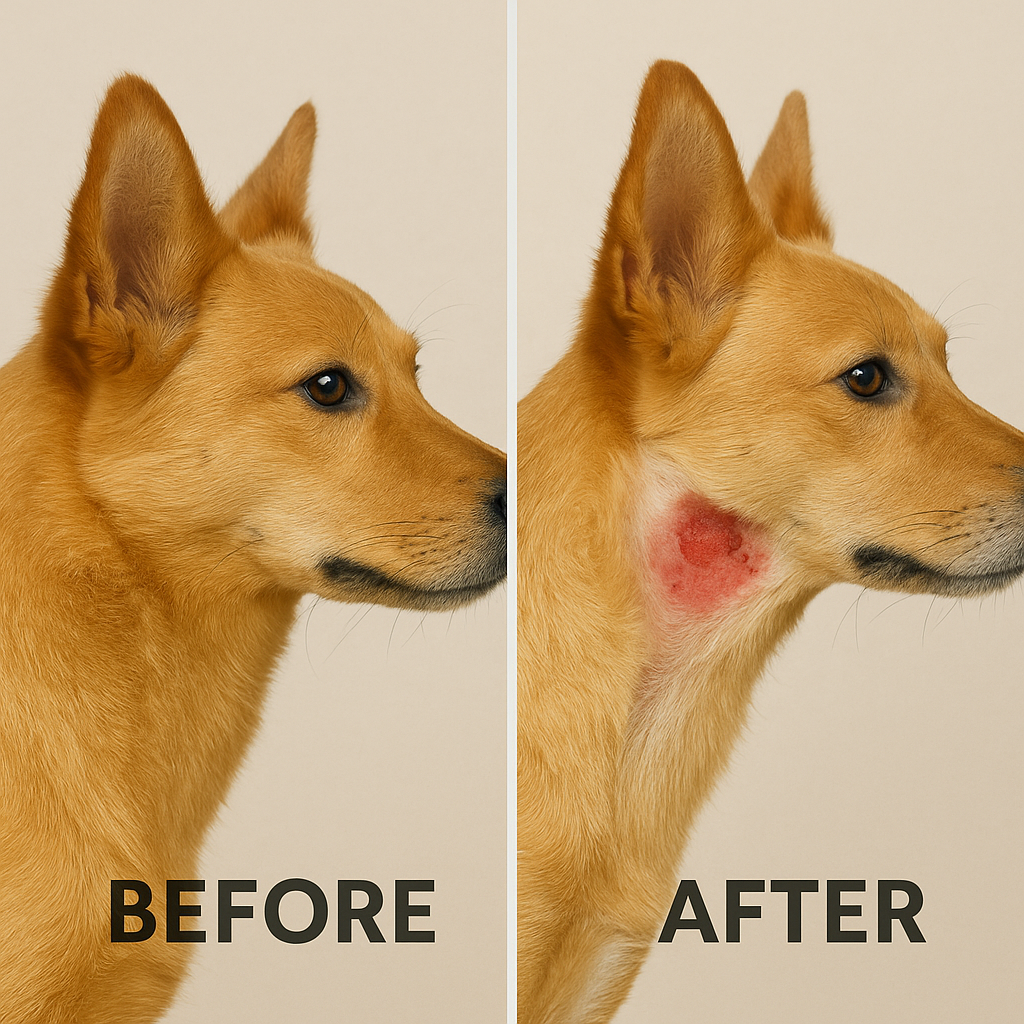
What They Look Like
Hot spots on dogs—also called acute moist dermatitis—are inflamed, moist, and often infected patches of skin that appear suddenly and worsen quickly. These lesions are typically red, raw-looking, and painful to the touch. They may ooze clear fluid or pus and are frequently accompanied by hair loss in the affected area.
Most pet parents describe seeing a “wet scab” or “angry sore” that their dog can’t stop licking or scratching. As a vet, I’ve seen dogs go from a small irritated spot in the morning to a large open wound by night. This rapid progression makes early intervention crucial.
Common Locations
Hot spots on dogs can occur anywhere on the body but are most often found in areas your dog can easily reach, including:
- Under the ears or jaw
- Base of the tail
- Inner thighs
- Neck and chest
- Legs and paws
In breeds with thick coats like Golden Retrievers, German Shepherds, and Labradors, hot spots may remain hidden under fur until they are quite advanced.
Why They Develop So Fast
Hot spots on dogs develop through a destructive cycle of itching, licking, and scratching. A minor skin irritation—like a bug bite or moisture under the fur—can trigger an intense urge to lick. This self-trauma breaks the skin, inviting bacteria in and escalating inflammation. Within hours, what started as a minor itch can become a full-blown infected sore.
This is one of the most frustrating things for pet owners—how fast it escalates. That’s why it’s so important to recognize and treat hot spots on dogs early.
What Causes Hot Spots on Dogs?
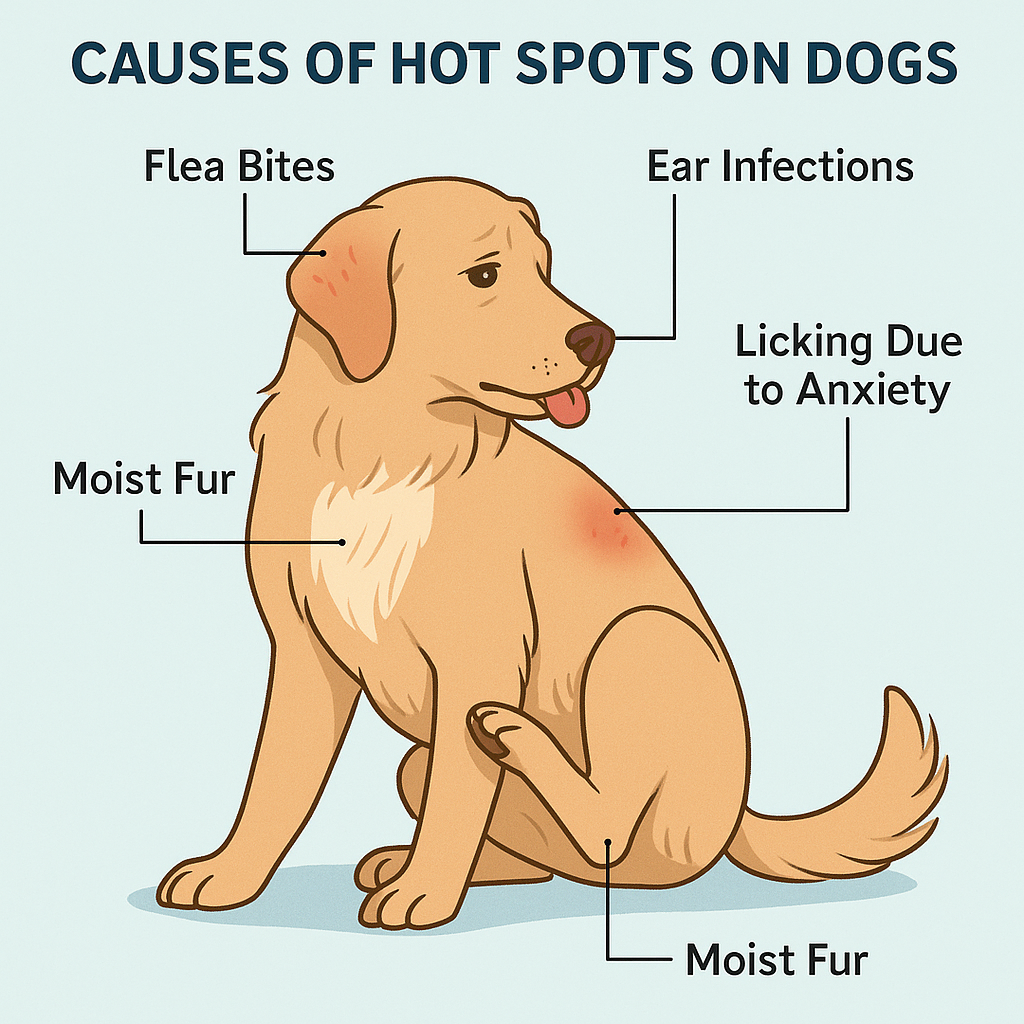
Understanding the root causes of hot spots on dogs helps prevent them from coming back. While the visible sore is a result of your dog’s licking or scratching, the trigger is usually an underlying issue. In my clinic, I always emphasize to pet parents: treat the cause, not just the wound.
Most Common Triggers
Here are the most frequent causes of hot spots on dogs, backed by sources like VCA Animal Hospitals and PetMD:
- Flea infestations: One flea bite can trigger hours of itching, especially in dogs with flea allergy dermatitis.
- Environmental allergies: Pollen, mold, dust mites, and grasses can cause relentless skin irritation.
- Food sensitivities: Ingredients like chicken, beef, dairy, or wheat may lead to skin inflammation.
- Moisture trapped under the coat: Common after swimming or bathing, especially in thick-coated breeds.
- Ear infections: Dogs with floppy ears often scratch the base of the ears, creating hot spots.
- Anal gland issues: Scooting and licking the rear end can break the skin and lead to infection.
- Poor grooming or matted fur: Trapped debris and moisture create the perfect environment for bacteria.
- Behavioral factors: Boredom, anxiety, or pain (e.g., arthritis) can lead to obsessive licking.
Hidden Health Problems
Sometimes hot spots on dogs are a sign of deeper health concerns. Recurrent lesions can indicate:
- Hypothyroidism
- Autoimmune skin disorders
- Chronic pain or neuropathy
- Immune suppression (e.g., from Cushing’s disease)
If your dog has frequent hot spots, it’s worth discussing diagnostic testing with your vet.
Table: Common Causes of Hot Spots on Dogs
| Cause | Symptoms You May Notice |
|---|---|
| Fleas | Scratching at tail base, visible flea dirt |
| Environmental allergies | Chewing paws, seasonal flare-ups |
| Food allergies | Chronic ear infections, diarrhea, itchy skin |
| Moisture under coat | Wet smell, recent swim or bath |
| Ear infections | Head shaking, odor from ears |
| Anal gland issues | Scooting, licking rear |
| Anxiety or boredom | Licking legs when alone or under stress |
Home Treatment: 5 Safe Steps for Hot Spots on Dogs
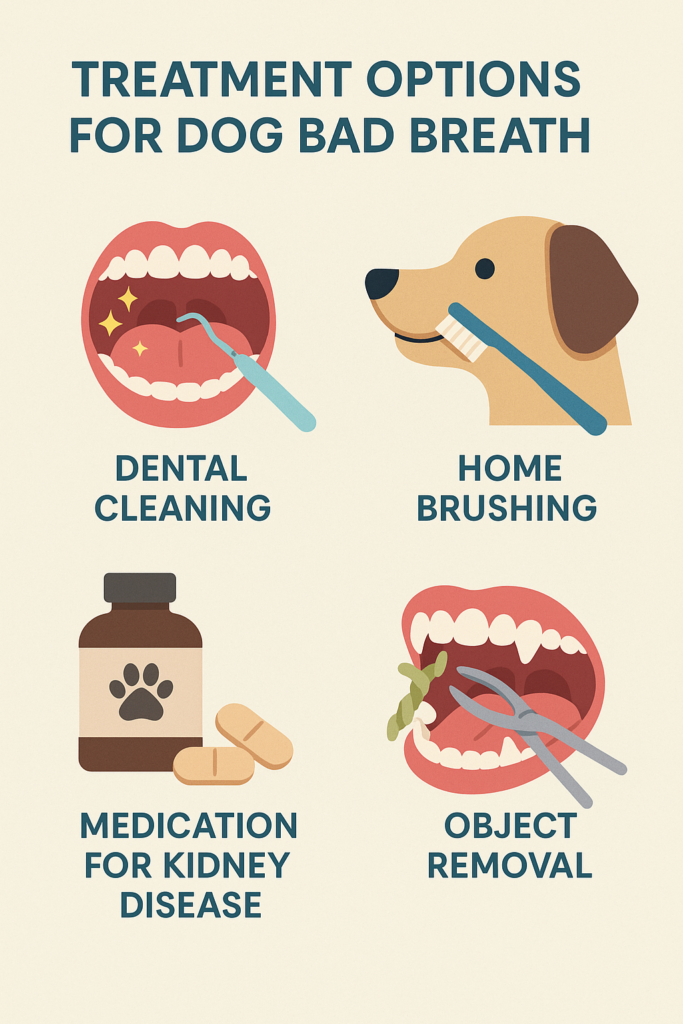
For small, non-infected lesions less than 24 hours old
If caught early, mild hot spots on dogs can often be managed safely at home. Here’s the five-step protocol I recommend to my clients. Be sure to act gently—hot spots can be painful, and some dogs may react defensively.
📝 5-Minute Home Care Checklist
- Use an E-collar or soft cone to stop licking
- Clip fur around the hot spot (carefully!)
- Clean twice daily with antiseptic solution
- Apply a dog-safe topical spray
- Monitor for improvement over 3–5 days
Step 1 – Stop the Itch
The first step in treating hot spots on dogs is to prevent further self-trauma.
- E-collars (cones): Rigid or soft recovery cones stop your dog from licking the area.
- Inflatable collars: Great for head or upper body hot spots.
- Bandages: Temporary protection, but must be changed daily to prevent moisture buildup.
🧠 Vet Tip: Avoid punishment—licking is your dog’s way of trying to relieve discomfort.
Step 2 – Clip the Fur
Trimming fur improves airflow and allows topical treatments to work.
- Use electric pet clippers (not scissors).
- Trim at least 1 inch beyond the edge of the lesion.
- If your dog is sensitive or aggressive, your vet can sedate and clip safely.
Hot spots on dogs that remain hidden under fur tend to worsen quickly. I’ve seen cases where owners missed lesions for days due to thick coats.
Step 3 – Clean the Area
Twice daily cleaning reduces bacteria and soothes the skin.
✅ Use:
- Chlorhexidine 2–4% solution
- Pet-safe antibacterial wipes (like Douxo®)
- Mild, unscented soap (Cetaphil, Aveeno, or Castile)
🚫 Avoid:
- Alcohol, hydrogen peroxide (sting and delay healing)
- Ointments like Vaseline® or Neosporin® unless advised by your vet
Hot spots on dogs need to stay dry. Gently pat the area with a clean towel after cleaning.
Step 4 – Apply a Safe Topical
Topical treatments relieve itching and fight infection.
- Vetericyn® Plus Antimicrobial Spray: Safe if licked. Buy on Chewy
- Vet’s Best Hot Spot Spray: Contains aloe and tea tree oil (dog-safe formula).
- 1% Hydrocortisone cream: Use sparingly if your vet approves. Avoid use on broken skin.
Hot spots on dogs should never be treated with human creams unless your vet confirms they are safe.
Step 5 – Monitor for Healing
Signs of improvement include:
- Decreased redness and swelling
- Less licking or scratching
- Formation of a dry scab
Most mild hot spots on dogs resolve in 3–7 days. If it worsens or doesn’t improve, contact your veterinarian.
When to Call the Vet for Hot Spots on Dogs
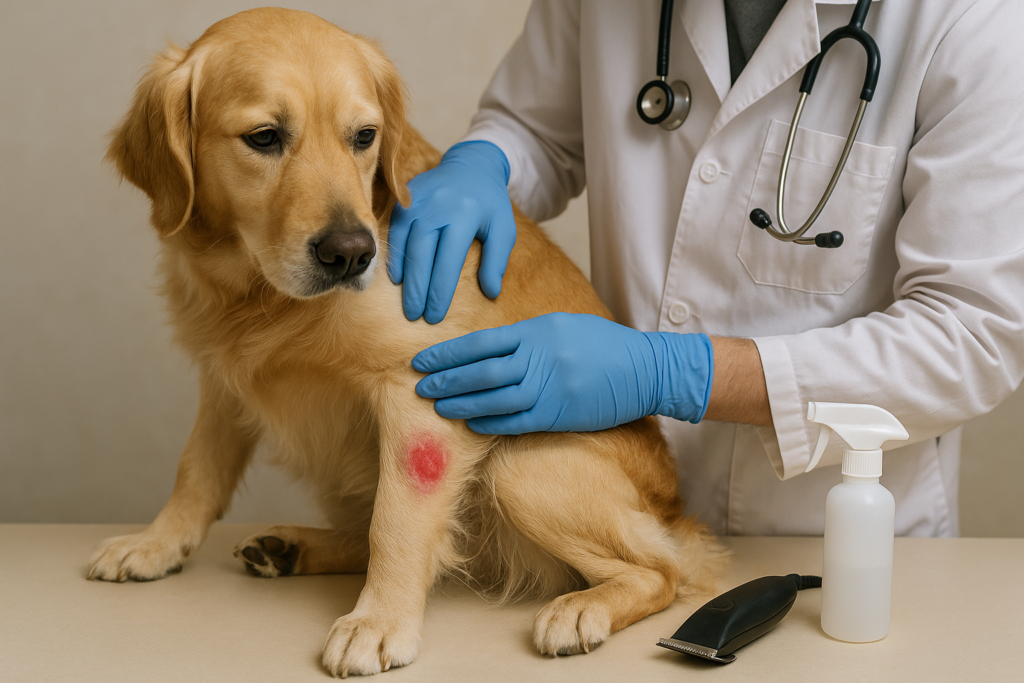
While some hot spots on dogs can be treated at home, others require veterinary attention to prevent serious infection or pain. If you notice any of the signs below, it’s time to book an appointment.
🚨 When Home Care Isn’t Enough
Call your vet if:
- The hot spot is larger than a toonie, growing rapidly, or very moist
- There’s colored discharge (yellow, green) or a foul smell
- Your dog seems in pain, lethargic, or keeps licking despite a cone
- The area bleeds easily, is crusting, or forms thick scabs
- You’ve tried home care for 3–5 days with no improvement
In my experience, the most common mistake owners make is waiting too long—especially if they think it’s “just a bug bite.” Some dogs need oral antibiotics or steroids to fully heal.
What to Expect at the Vet
Your vet will examine your dog’s skin and likely:
- Clip and clean the area (often under sedation)
- Take samples (cytology or culture) to check for bacteria or yeast
- Rule out parasites with a skin scrape
- Prescribe oral antibiotics or anti-inflammatories
- Discuss allergy, flea, or food triggers
We also look at lifestyle factors—like grooming, diet, and behavior—to prevent recurrence. For chronic or stubborn hot spots on dogs, a referral to a veterinary dermatologist may be helpful.
Preventing Hot Spots on Dogs
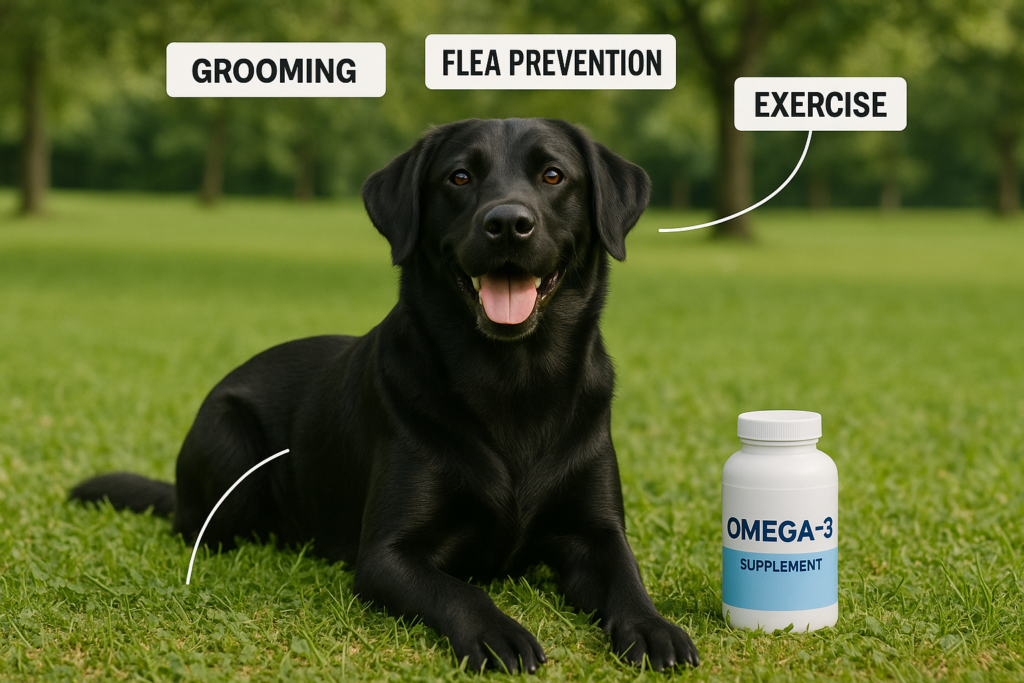
Once you’ve dealt with a painful episode, your next goal is to prevent it from happening again. In my Ottawa practice, I tell pet parents prevention isn’t just about clean skin—it’s about controlling the root causes.
Let’s look at practical, vet-backed strategies to keep hot spots on dogs from recurring.
Year-Round Parasite Control
Fleas are one of the most overlooked causes of hot spots on dogs.
- Use monthly preventatives like Frontline® Plus, NexGard®, or Simparica® year-round
- Treat all pets in the household, not just the itchy one
- Clean bedding and vacuum frequently
🧪 Tip: Even if you don’t see fleas, they might be present. A single bite can trigger a reaction.
Manage Allergies & Infections
If your dog has chronic hot spots, consider allergy testing or an elimination diet.
- Try hypoallergenic diets under vet guidance
- Use antihistamines (e.g., Zyrtec®, Benadryl®) or prescription options like Apoquel®
- Treat yeast or bacterial overgrowth with appropriate meds
Regular ear cleaning and anal gland expression can also reduce triggers.
Grooming & Drying
Good grooming habits are essential in preventing hot spots on dogs, especially in breeds with dense coats.
- Brush regularly to prevent matting
- Use a professional groomer for full de-shedding (especially during seasonal coat changes)
- Dry your dog thoroughly after baths or swimming
- Avoid leaving damp collars or harnesses on
In my clinic, I’ve seen many post-swim hot spots on dogs, particularly when the fur traps moisture around the neck or groin.
Mental & Physical Enrichment
Stress and boredom often lead to obsessive licking. Enrichment can break the cycle.
- Increase daily walks and off-leash play
- Use slow feeders, snuffle mats, and puzzle toys
- Rotate toys weekly to keep them exciting
- Consider daycare or training classes for social dogs
In severe cases, a vet may prescribe anti-anxiety meds like fluoxetine.
Skin Health Supplements
Omega-3 fatty acids reduce inflammation and support skin barrier function.
- Use fish oil with DHA and EPA
- Look for products like Welactin®, Grizzly Salmon Oil, or vet-recommended brands
- Ask your vet about dosage based on weight and breed
Balanced nutrition also helps. Some dogs improve dramatically on limited-ingredient or veterinary diets.
Keep a Close Eye
Regularly check high-risk areas: under the ears, chest, groin, paws, and tail base. If you spot early redness or your dog’s licking more than usual, act fast.
💰 Typical Canadian Vet Costs (2025)
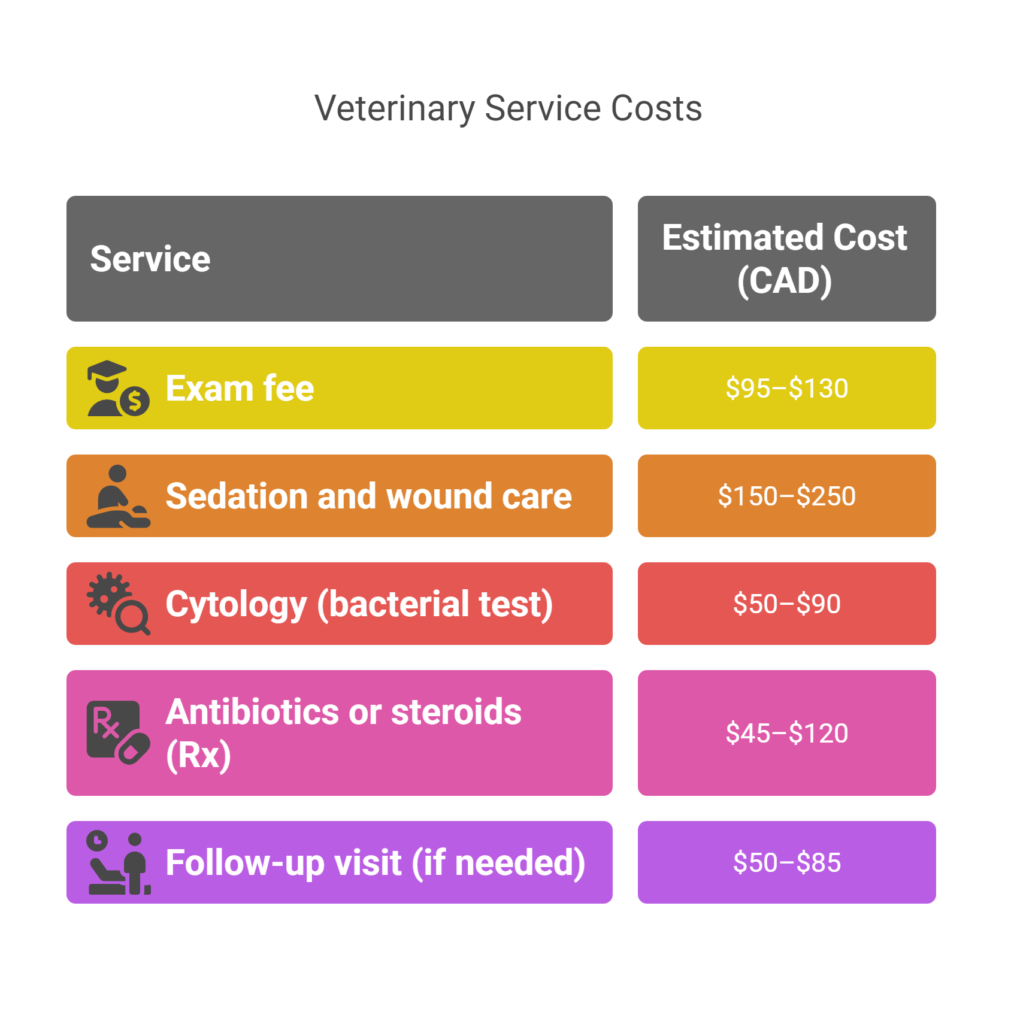
Pet insurance may cover hot spot treatment if it’s not pre-existing. Check your plan.
Frequently Asked Questions About Hot Spots on Dogs
Here are answers to the most common questions I get from pet parents in the clinic about hot spots on dogs:
What do hot spots on dogs look like?
They usually appear as raw, moist, red skin lesions. You may notice oozing fluid, hair loss, swelling, or a foul odor. Some dogs develop thick yellow crusts or scabs. Common locations include under the ears, on the neck, legs, or near the tail.
Are hot spots on dogs contagious?
No, hot spots are not contagious to other pets or people. They are caused by your dog’s own licking and scratching, usually triggered by allergies, moisture, or infection.
Can I put Neosporin or Vaseline on my dog’s hot spot?
Avoid using Neosporin® ointment or Vaseline®, as they can cause excessive licking and may be harmful if ingested. Only use products that are labeled as dog-safe, such as Vetericyn® or a vet-recommended hydrocortisone spray.
How long do hot spots on dogs take to heal?
With proper home care, mild hot spots on dogs usually heal within 3 to 7 days. More severe cases treated by a vet may take up to two weeks. Healing time depends on the size, location, and whether there’s a secondary infection.
What’s the best flea prevention to avoid hot spots?
Any monthly flea and tick preventative prescribed by your vet will help. Popular options include:
Keeping your dog flea-free is a crucial step in preventing hot spots on dogs.
Should I pop or drain a hot spot?
No. Never attempt to pop, lance, or drain a hot spot at home. This can worsen infection and cause pain. Instead, clean gently and let your vet decide if intervention is needed.
Summary Table: Hot Spot Treatment & Prevention
Here’s a quick-reference table to help you manage and prevent hot spots on dogs at every stage:
| Aspect | Details |
|---|---|
| Home Treatment Steps | – Stop licking with a cone or barrier – Trim fur with pet-safe clippers – Clean twice daily with chlorhexidine or mild soap – Apply vet-approved topical spray – Monitor for signs of healing (3–7 days) |
| When to See a Vet | – Lesion is large, growing, bleeding, or oozing – Dog is in pain or can’t stop licking – No improvement within 3–5 days |
| Vet Clinic Treatments | – Wound cleaning and clipping (may need sedation) – Antibiotics or anti-inflammatory meds – Cytology or allergy testing – Flea/allergy treatment |
| Prevention Tips | – Monthly flea/tick prevention (e.g., Simparica®, Frontline®) – Regular grooming and full drying after baths – Omega-3 supplements – Stress management and daily enrichment – Treat underlying allergies or infections |
| What to Avoid | – Human ointments (Neosporin®, Vaseline®) – Alcohol, peroxide, or scented soaps – Ignoring signs of recurring lesions |
Conclusion
Hot spots on dogs can be distressing for both pets and their owners—but they’re also very treatable with prompt action and the right care. Whether it’s a small sore that clears up at home or a more advanced lesion needing veterinary help, the key is to address the hot spot early and prevent self-trauma.
As a veterinarian, I’ve seen dogs go from miserable to wagging happily within a few days of starting treatment. But when underlying issues—like allergies, fleas, or anxiety—aren’t dealt with, hot spots can come back again and again. That’s why prevention is just as important as treatment.
Your dog depends on you to catch these issues early, provide comfort, and work with your vet to manage any ongoing problems. With some patience, routine care, and the right tools, you can keep your dog’s skin healthy and happy.
If you’re ever unsure whether a lesion is a hot spot or something more serious, always reach out to your veterinary team for guidance. When in doubt, it’s better to ask than to wait.

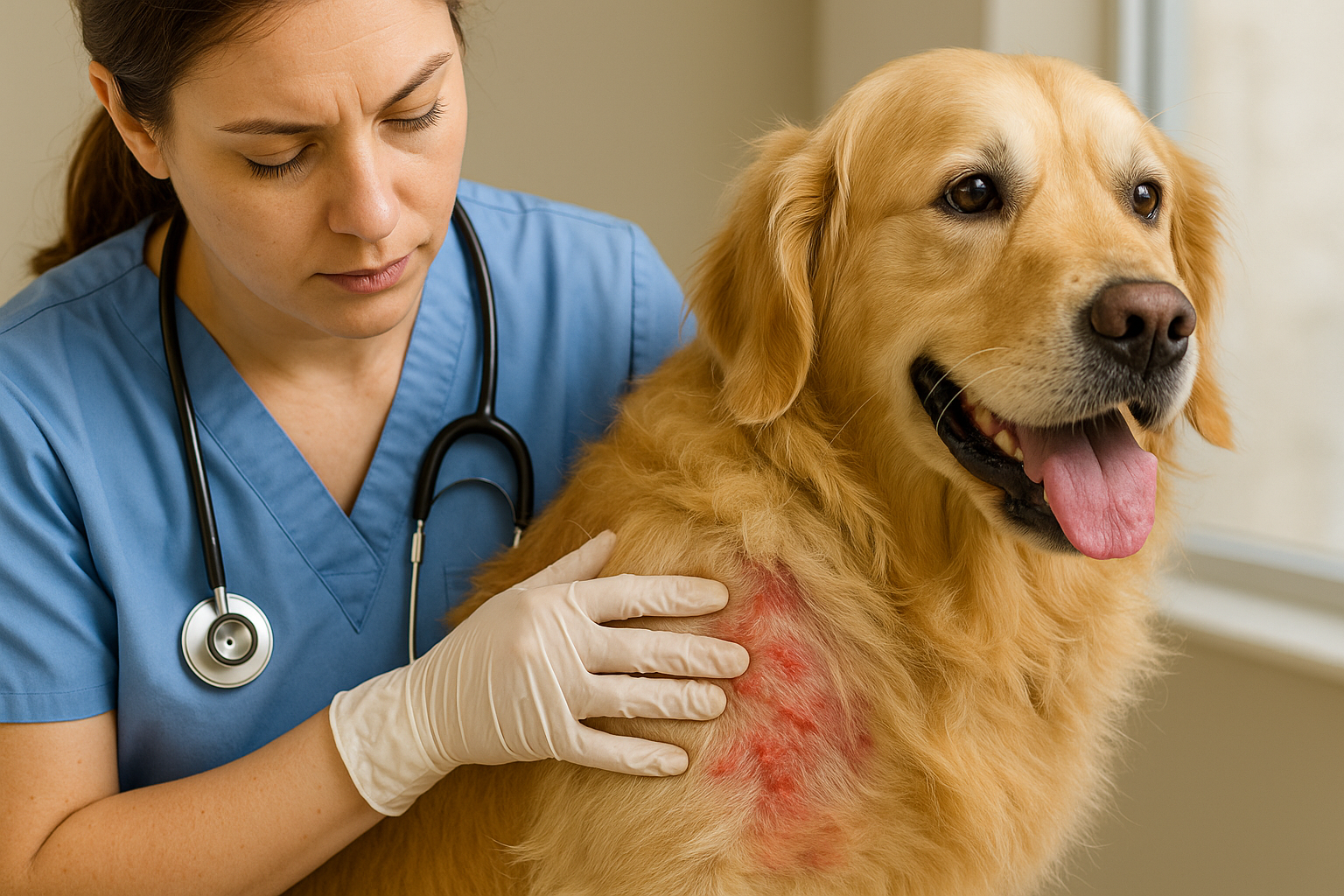
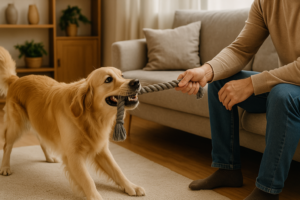

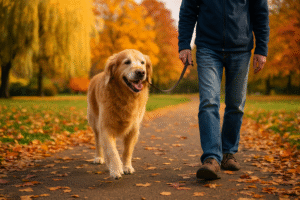
Pingback: Dog Seizures in 2025: Top 10 Causes, Symptoms & Proven Treatments